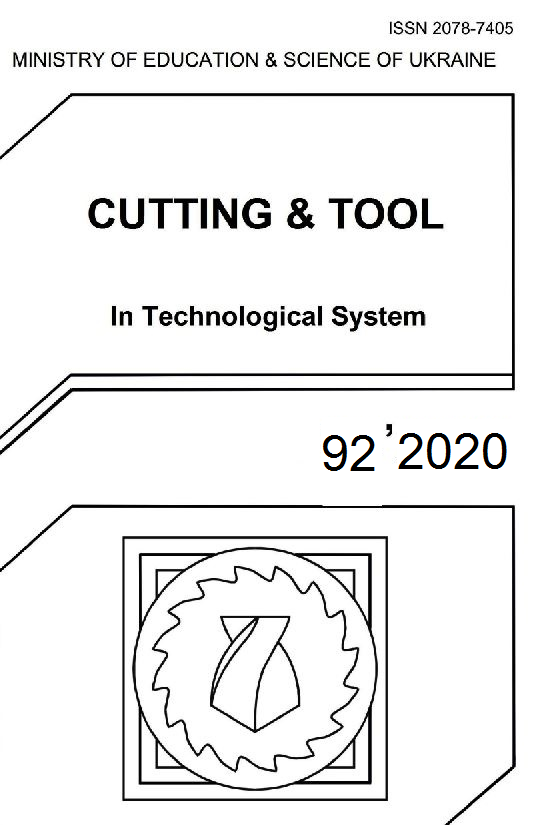EXPERIMENTAL STUDY ON SURFACE ROUGHNESS OF FACE MILLED PARTS WITH ROUND INSERT AT VARIOUS FEED RATES
DOI:
https://doi.org/10.20998/2078-7405.2020.92.11Keywords:
surface roughness, symmetrical face milling, round insert, feed rate.Abstract
In the present paper, the variation of surface roughness of machined parts during symmetrical face milling is investigated. During this experimental work, the effect of using a milling insert with a round geometry under various feed rate values on the topography of milled parts is examined. For that purpose, both 2D and 3D surface roughness measurements were performed in three planes parallel to the feed direction, with one of the planes being on the symmetrical plane and the other two being at the same distance from it but in opposite sides. The analysis of the experimental results indicated that although surface roughness increases gradually with increase of feed rate, a considerable increase of surface roughness occurs for feed rate values over 0.4 mm/tooth. Moreover, the overall higher surface roughness values were found to be on the symmetrical plane, which was also more affected by the increase of feed rate than the other two planes.References
Alharthi, N.H., Bingol, S., Abbas, A.T., Ragab, A.E., El-Danaf, E.A., Alharbi, H.F.: Optimizing cutting conditions and prediction of surface roughness in face milling of AZ61 using regression analysis and artificial neural network, Advances in Materials Science and Engineering, 7560468. (2017)
Subramanian, A.V.M., Nachimuthu, M.D.G, Cinnasamy, V.: Assessment of cutting force and surface roughness in LM6/SiCp using response surface methodology, Journal of Applied Research and Technology 15, pp. 283-296. (2017)
Pathak, B.N., Sahoo, K.L.,
Mishra, M.: Effect of Machining Parameters on Cutting forces and surface roughness in Al-(1-2) Fe-1V-1Si Alloys, Materials and Manufacturing Processes 28(4), pp. 463-469. (2013)
Hernandez-Gonzalez, L.W., Perez-Rodriguez, R., Quesada-Estrada, A.M., Dumitrescu, L.: Effects of cutting parameters on surface roughness and hardness in milling of AISI 304 steel, Dyna 85(205), pp. 57-63. (2018)
Selaimia, A.A., Yallese,M.A., Bensouilah, H., Meddour, I.,
Khattabi, R., Mabrouki,T.: Modeling and optimization in dry face milling of X2CrNi18-9 austenitic stainless steel using RMS and desirability approach, Measurement 107, pp. 53-67. (2017)
Hoang, T.D., Nguyen, N.T., Tran, D.Q., Nguyen, V.T.: Cutting forces and surface roughness in face milling of SKD61 hard steel, Journal of Mechanical Engineering 65(6), pp. 375-385. (2019)
Torta, M., Albertelli, P., Monno, M.: Surface morphology prediction model for milling operations, The International Journal of Manufacturing Technology 106(7-8), pp.3189-3201. (2020)
Arizmendi, M., Jiménez, A.: Modelling and analysis of surface topography generated in face milling operations, International Journal of Mechanical Sciences 163, pp. 105061. (2019)
Felhő, C., Karpuschewski, B., Kundrák, J.: Surface roughness modeling in face milling, Procedia CIRP 31, pp. 136-141. (2015)
Jin, S., Liu, S., Zhang, X., Chen, K.: A unified prediction model of 3D surface topography in face milling considering multi-error sources, The International Journal of Advanced Manufacturing Technology 102 (1-4), pp. 705-717. (2019).
Svalina, I., Havrlišan, S., Šimunović, K., Šarić, T.: Investigation of Correlation between Image Features of Machined Surface and Surface Roughness, Tehnički vjesnik, 27(1), pp. 27-36. (2020)
Pimenov, D.Yu.,Bustillo, A., Mikolajczyk, T.: Artificial intelligence for automatic prediction of required surface roughness by monitoring wear on face mill teeth, Journal of Intelligent Manufacturing 29(5), pp. 1045-1061. (2018)
Abbas, A.T., Pimenov, D.Y., Erdakov, I.N., Mikolajczyk, T., Soliman, M.S., El Rayes, M.M.: Optimization of cutting conditions using artificial neural networks and the Edgeworth-Pareto mehod for CNC face-milling operations on high-strength grade-H steel, The International Journal of Advanced Manufacturing Technology 105(5), pp. 2151-2165. (2019)
Bağci, E., Aykut, Ş.: Influence of symmetric and asymmetric machining strategies on surface roughness in face milling process of cobalt-based superalloy, Journal of the Balkan Tribological Association 19(1), pp. 23-26. (2013)
Pimenov, D.Y., Hassui, A., Wojciechowski, S., Mia, M., Magri, A., Suyama, D.L., Bustillo, A., Krolczyk, G., Gupta, M.K.: Effect of the relative position of the face milling tool towards the workpiece on machined surface roughness and milling dynamics, Applied Sciences 9(5), pp. 842. (2019)
European Steel and Alloy Grades, C45, https://tinyurl.hu/GtDr/.
Downloads
Published
Issue
Section
License
Copyright Notice
Authors who publish with this Collection agree to the following terms:
1. Authors retain copyright and grant the Collection right of first publication with the work simultaneously licensed under a Creative Commons Attribution License that allows others to share the work with an acknowledgement of the work's authorship and initial publication in this Collection.
2. Authors are able to enter into separate, additional contractual arrangements for the non-exclusive distribution of the Collection's published version of the work (e.g., post it to an institutional repository or publish it in a book), with an acknowledgement of its initial publication in this Collection.
3. Authors are permitted and encouraged to post their work online (e.g., in institutional repositories or on their website) prior to and during the submission process, as it can lead to productive exchanges, as well as earlier and greater citation of published work.

